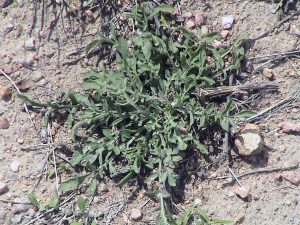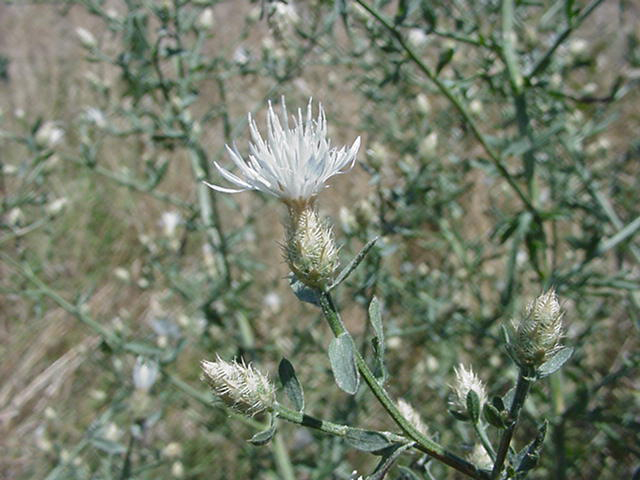Diffuse Knapweed (Centaurea diffusa)
Identification
Diffuse knapweed is native to the eastern Mediterranean region and to western Asia. In the beginning of the 1900’s, diffuse knapweed found it’s way to North America in alfalfa seed shipments.
Diffuse knapweed is a biennial, which means its first year of growth is a basal rosette of leaves from a deep taproot. Rosettes can appear in either spring or fall. During the second year, the stem bolts 1.5 to 3 feet tall. Stem leaves become smaller higher up the stem. Urn-shaped flower heads are mostly white, sometimes purple, and are located on each branch tip. The bracts surrounding each flower bear 4 to 5 pairs of lateral spines which are painful to the touch.
Diffuse knapweed has been credited with reducing biodiversity, increasing soil erosion, reducing land value, increasing cost of roadside maintenance, threatening Natural Area Preserves, and replacing wildlife and livestock forage on rangeland and pasture. During the winter, these plants will break off at the base of the stem and form tumbleweeds. These tumbleweeds are blown around by the wind therefore spreading seed to uninfested areas.
Cultural Management
Seeding and maintaining aggressive grasses will help in competing with diffuse knapweed and slow its spread. However seeding alone in infected areas will not provide adequate control. Proper fertilization, grazing, and supplemental irrigation of grasses are always effective cultural control methods.
Supplemental control methods, such as judicious use of herbicides, may be needed to give grasses a chance to compete. Additional herbicide treatments after grass establishment may be needed to keep diffuse knapweed populations reduced to an acceptable level.
It produces early spring growth that is hard to compete against.
More complete information on grasses can be found on the Grass Seeding on the Eastern Front-Range of Colorado page or by contacting the Natural Resources Conservation Service.
Mechanical Management
 Mowing (or other mechanical efforts) diffuse knapweed when it is in the bud stage, and again when it flowers, will significantly reduce seed production. Preventing seed set for a number of years will eventually eliminate an infestation, once the seed source in the soil is depleted. This assumes no seed enters the area from an outside source. This weed has been known to flower at a plant height below mower level.
Mowing (or other mechanical efforts) diffuse knapweed when it is in the bud stage, and again when it flowers, will significantly reduce seed production. Preventing seed set for a number of years will eventually eliminate an infestation, once the seed source in the soil is depleted. This assumes no seed enters the area from an outside source. This weed has been known to flower at a plant height below mower level.
Diffuse knapweed can be easy to pull by hand. Get at least 2/3 of the root. Start in May as plants bolt. Leave plants on the ground if they haven’t flowered; otherwise bag them and dispose. Wear gloves and long-sleeved shirt. Handpulling is effective on small patches, but is not recommended for large infestations.
Biological Management
Two species of seedhead flies (Urophora affinis and U. quadrifasciata) reduce the seed production of this weed. When combined with a root-boring beetle (Sphnoptera jugoslavica), diffuse knapweed control is increased. Sheep will graze young plants from spring to early summer. Cattle will eat diffuse knapweed young growth. Goats will also eat it.
Herbicide Management
Few Herbicides are labeled for use on diffuse knapweed. Those that have been effective when used independently or in combination with each other are: picloram (Tordon), dicamba (Banvel), clopyralid (Stinger, Transline), clopyralid + 2,4-D (Curtail) and 2,4-D. The latter used alone works poorly.




